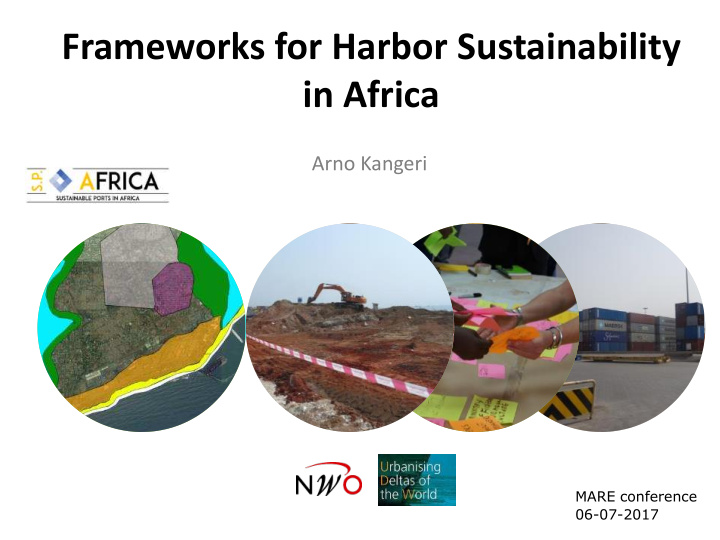



Frameworks for Harbor Sustainability in Africa Arno Kangeri MARE conference 06-07-2017
Existing Harbour and Environs
Traditional Harbour Expansion
Sustainable Harbour Expansion Concept
What is sustainable? Natural? Idyllic recreation spot? Limited usage?
What is sustainable? Idyllic recreation spot? Natural? Limited usage?
What is sustainable? the sustainable port • "A sustainable port is a port which has achieved and is maintaining a balance in economic, environmental and social extent for the surrounding local region. A sustainable port uses the Earth’s resources for its own benefit without affecting its capacities for future generations.” Zhen Zhen Zheng
What is sustainable? Economic: Function as a port Allow for future change Limit long term costs Smart use of ecosystem services Environmental: Room for (semi)natural environment Social: Room for recreation Create jobs Improve quality of life
What is sustainable? Economic: Function as a port Environmental: Allow room for (semi)natural environment Maasvlakte II: Port of Rotterdam
Approach Goals • Tools to facilitate integrated and sustainable port development. • Development of Framework & Guidelines • Quick design tools: remote sensing data & ecological data • Green Ports Network : Community of researchers, private sector and port related stakeholders.
Approach
Understanding the System Case Study: Tema, Ghana
Understanding the System
Understanding the System Quantifying Change No erosion Sedimentation Sedimentation
Understanding the System Mapping Change Oral Accounts Old Images
Understanding the System Mapping Change
Understanding the System Valuing Change
Planning the Future Bottom up Capacity building Mapping the past Mapping Interest Groups Designing Futures
Planning the Future Bottom up
Planning the Future e.g. Exploration port lay-outs Natural port Offshore berth Port behind a breakwater Open port Port behind an island e.t.c.
Planning the Future Design for Multifunctionality e.g. Safety Secondary submerged breakwaters grow with sea level/ cheaply upgraded Water Quality/Pollution Quay walls to facilitate growth of bio-filtration Fishery Porous breakwaters promoting fish nursery function of harbour Tourism Attention for Back port area and natural areas • Potential for attracting tourists and Cruise vessels. e.t.c.
Scaling Up Practicing change and changing practices. Vreugdenhil (2010) • Pilot projects – Routinization – Replication – Institutionalization – Diffusion
Scaling Up Decision Makers, Pan-African Ports Network Practicing change and changing practices. Ripple effects of Replicated practices Institutionalized new practices in in Ghana and practices in African port development in beyond port development Ghana Phase 1 Phase 2 Phase 3
Scaling Up Enhancing diffusion 1. Include diffusion activities in the project planning – Devote resources to diffusion from the outset 2. Adopt a balanced, supported knowledge programme – Diverse types of knowledge , critical actor support 3. Explicate context dependency, representativeness – Too representative, not manageable nor practical – Too limited in scope, not transferrable 4. S pread knowledge and validate – Scientific, professional publications ? – Multiple pilots to reduce context dependency 5. Identify, connect to current, future application areas, users, institutions 6. Exercise an open , adaptive governance style with constructive social learning 7. Facilitate a gradual transfer of ownership
Project Partners • Technical University Delft (NL) • University of Ghana-Legon • UNESCO-IHE • Wageningen University Marine Research (NL) • Free University (VU) Amsterdam • Deltares • WWF • NABC (Netherlands African Business Council)* • *Royal Boskalis (Dredging & Marine Experts), Van Oord Dredging, Dame Shipyards, Port of Amsterdam, Port of Rotterdam, Deep BV, STC, FMO, CWT Sitos
Recommend
More recommend